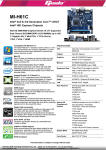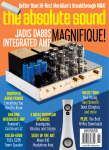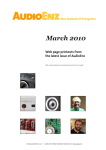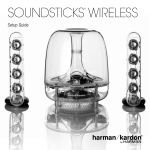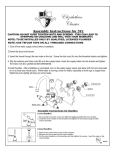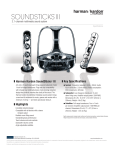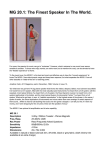Download The Absolute Sound
Transcript
REPRINTED FROM AUGUST 2010 Start ME UP B&W MM-1 Computer Loudspeaker B&W branches out with a nifty new speaker for—yes—your desktop! Wayne Garcia F or lovers of good sound, spending time in front of your computer for anything besides work can be—to quote Walter, friend of His Dudeness—akin to entering a world of pain. The miniscule drivers lodged within our computer chassis just don’t cut it, even if your aural desires extend to nothing more taxing than live streaming an NPR program. This, of course, is not exactly headline news. For years now both mainstream and specialty audio manufacturers have been building desktop speakers for people who prefer not to have their computer-driven music or video sound as if it’s coming from the bottom of a rusty Folgers can. My first experience with after-market computer speakers was with Harman Kardon Soundsticks. Not bad for their day. But like many desktop speakers the Soundsticks relied on a separate, relatively large, and cumbersome-to-place “subwoofer” to generate any bass. And, as with many sub-sat rigs, getting the sound to gel—especially when placing the sub so it wasn’t constantly in danger of getting kicked around under the desk— was difficult if not impossible. And yes, I’m aware that there are many good-sounding desktop models that don’t use a subwoofer. Although they may have much to recommend them sonically, I find the majority of these designs to be: a) too large for my desktop; b) not very attractive; and c) if in themselves not bad looking then typically not a good visual match with my iMac (yes, I do care about such things). Which is where the engineers at one of England’s venerable speaker makers, Bowers & Wilkins, enter the picture with their new MM-1 ($499), which the company is calling a “computer,” as opposed to a “desktop,” speaker. But before we get to the MM-1, let’s consider just a few of the challenges traditional high-end audio manufacturers face when branching into new product categories. One danger, of course, is simply wading, and possibly sinking, into unfamiliar waters. Without naming names, it isn’t too tough to imagine products from established firms that seem like they were created simply because the manufacturer felt pressure to jump on a popular bandwagon. (Two-channel electronics manufacturers who tried and flopped at developing working— To subscribe to the absolute sound, call 888-475-5991 (US), 760-745-2809 (outside US) or visit www.theabsolutesound.com. $42 for six issues in the US; $45 Canada, $75 outside North America. Posted with permission from NextScreen, LLC. All rights reserved. Any unauthorized duplication of this article is strictly prohibited. For more information on use of this content, contact Wright’s Media at 877-652-5295. START ME UP let alone competitive—home-theater processors are an obvious case in point.) Another is credibility. If you’ve developed a reputation for making the most delectable chocolate confections and suddenly decide gummy bears are your next product, well, your customer base may raise an eyebrow or two. Use your own audio analogy here. And while I’m only skimming the list of challenges, let’s jump ahead to the credibility of your existing line. How to maintain your reputation for excellence, while branching into realms that are frequently looked down on by hardcore hobbyists but that are wildly popular with regular consumers (iPod and computer products most obviously fill this category)? The simple answer to all of these questions is: “You build excellent products that maintain your company’s integrity by building on its history.” Here is where team B&W excels. What that firm calls its “new media” division began a few years back with the introduction of the Zeppelin (reviewed by Robert Harley in Issue 178), a coollooking iPod docking device that looked like its name and that sounded pretty darn fine, to boot. The $599 Zeppelin flew solo for a while, but in late-’09 B&W introduced the Zeppelin Mini ($399), which brought much of the same technology—if not quite the same sound—into a smaller package. Wasting no time, B&W has now launched the MM-1 under consideration here, as well as its first-ever set of headphones, the P5 ($299), which, while not ear “buds,” are designed for mobile music use. Standing a mere 3.9" x 6.7" x 3.9" and finished with spun aluminum top plates and black grille cloths, the MM-1s are—to these eyes, anyway—both attractive and small enough to earn a spot flanking my iMac, which they seem designed to match up with. Inside each speaker’s rounded edges B&W has managed to fit a pair of 3" woofers and two 1" Nautilus tube-loaded aluminumdome tweeters. Here’s an example of how B&W has managed to draw on its history by placing its once exotic and now practically ubiquitous Nautilus tweeter technology into a new and very mainstream product. Four tiny 18-watt Class D amplifiers power the drivers, and the amps are housed in the right-channel SPECS & PRICING Driver complement: Two 1" Nautilus tube-loaded aluminum dome tweeters; two 3" woofers Frequency response: -6dB at 57Hz and 22kHz Amplifier power output: 4 x18W Features: USB streaming from PC/Mac; remote control Inputs: 3.5mm mini jack (analog); Mini USB B 2.0 for PC connection (streaming & software upgrades) Outputs: 3.5mm mini jack (headphone) Dimensions: 3.9" x 6.7" x 3.9" Weight: 1.7 lbs. Price: $499 B&W LOUDSPEAKERS OF AMERICA 54 Concord Street North Reading, Massachusetts 01854 (978) 664-2870 www.bowers-wilkins.com ASSOCIATED EQUIPMENT Apple iMac Comment on this article on the Forum at avguide.com “master” speaker, whose aluminum band also functions as an On/Off switch and manual volume control. The top plate also seems to function as something of a heat sink, as you’ll find it warm to the touch. The MM-1s’ digital signal is fed directly from a USB port, which in turn drives B&W’s DSP technology, which was evidently tuned to maximize the speaker’s clarity, balance, and relative ease at high volumes. A mini input jack allows you to plug an iPod directly into the speakers, and another outputs the sound to headphones through DACs that are far superior to those found inside computers. A small, black, egg-shaped remote is supplied, as are simple hookup instructions. (My only gripe about the set-up guide is that it neglects to tell you how to power the things up—by pressing the inner-rear portion of the aluminum band. After some 10 minutes checking connections and settings and then wondering if my review speakers were defective, I was able to figure this out. Still, guys, please revise!) As to the sound, the first thing that struck me about the MM-1 is its natural way with voices, both singing and spoken word. The latter was evident while streaming Hearts of Space program intros by the Rod Serling-like voiced Stephen Hill, as well as talk radio shows such as Fresh Air. But the MM-1’s clarity, lowcoloration, and articulation really hit home while I was watching DVDs of David Milch’s Deadwood series. As anyone who has watched it knows, the show’s brilliant dialog combines a sort of Elizabethan/Victorian/formalistic/purple prose with some of the foulest language to ever leave the mouths of actors. A lot of it is also deliberately convoluted, and it’s easy to miss the meaning. A lot of subtle things I’d missed with my computer’s built-in speakers became remarkably clear—and even funnier— through the MM-1s. I’ve never much liked viewing YouTube music videos. Although the site has a lot of great stuff to explore, I would rarely make it all the way though a song because of crappy computer sound. So I was pleased to log in and see Jeff Beck at Ronnie Scott’s Club 2007. Each song is a treat, but I especially like “Brush With the Blues,” a tune I’ve written about on CD in which Beck manhandles his Stratocaster to wonderful result. While I’m not going to tell you that the sound is the same as sitting in front of my reference two-channel rig, I will say that I was thoroughly engrossed playing the Beck piece through the MM-1s. While Beck’s Strat screams for mercy, his rhythm section keeps up a driving groove. Via the MM-1s, bass and drum lines have a notable tunefulness, a fine balance, and a welterweight’s punch. No, the MM-1 isn’t going to plunge bass notes like a separate sub will, but I found the bass quality plenty satisfying— even at pretty loud levels—and not having a separate box to deal with was a relief. Though some may wish to push them harder, the MM-1s played plenty loud enough for me, while also keeping their composure. For kicks (and out of curiosity), I played the CD of the René Jacobs performance of Figaro on Harmonia Mundi. As a miniature soundstage of notable openness unfolded before me, with solid imaging, the MM-1’s inherent midrange excellence was again verified by these gorgeously recorded vocals. After several weeks of exploring all kinds of music on CD and video, radio shows, and movies on DVD, my enthusiasm for B&W’s little computer speaker has only grown. Although it won’t deliver the sheer volume and bottom-end weight of larger or three-piece designs, the MM-1’s elegant look and build-quality, combined with its surprisingly natural midrange and good overall balance, is something I can wholeheartedly endorse. 68852


